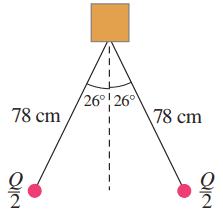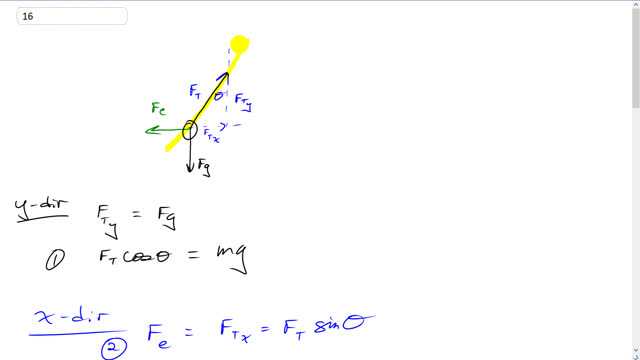
A large electroscope is made with “leaves” that are 78-cm-long wires with tiny 21-g spheres at the ends. When charged, nearly all the charge resides on the spheres. If the wires each make a angle with the vertical (Fig. 16–55), what total charge Q must have been applied to the electroscope? Ignore the mass of the wires.


In order to watch this solution you need to have a subscription.
This is Giancoli Answers with Mr. Dychko. Here's a free body diagram of one of the balls on the leaves of the electroscope. We have the tension along the leaf pulling up into the right at this angle θ to the vertical. That's 26 degrees there. There's an electrostatic repulsion straight to the left due to the other ball which is on this leaf over here. Then there's gravity straight down as well. So all these things are in equilibrium which means that the y-component of the tension force upwards equals the gravity downwards. This y-component is tension force times cosθ because this is adjacent leg of this triangle. FT cosθ equals mg. And then when you consider the x-direction, the electrostatic repulsion between the two balls equals the x-component of the tension force. And that's FT times sinθ because this is the opposite leg of this triangle. So we can rearrange equation one and solve it for FT. That's m g over cosθ when you divide both sides by cosθ. And then substitute that for tension force in equation two. And so we can say the electrostatic force is mg over cosθ times sinθ. And you need to memorize, although you don't really have to actually, but it's cleaner to read it as sinθ over cosθ is tanθ. But if you don't do that, that's totally fine. You can just plug the sine of 26 degrees divided by cos 26 degrees. Then you'll get the same as if you typed in tan 26 degrees. Electrostatic force can be written with Coulomb's Law. Coulomb's constant times one charge times the other charge, but each charge is the total of charge of Q over two. The total charge given to this electroscope is Q and it's divided evenly between the two leaves. That's concentrated on the balls at the end of the leaves as we're told. Each ball has a charge of Q over two. Q over two times Q over two is Q over two squared times k over the distance between them squared. that's the horizontal distance between them, and it's going to be a bit of work to calculate what that is, but it's not so bad, we'll get there in a minute. So we have kQ2 over four r 2 is mgtanθ. After you square this bracket, you'd end up with this line here. So for Q2, by multiplying both sides by four r2 over k. Then you get Q2 is four r2mgtanθ over k. And take the square root of both sides, and the charge, the total charge which is what we're trying to find here is two r, after you take the square root of that, times square root of mgtanθ over k. Now I need to substitute for r. We know what the length of one of the leaves is, it's 78 centimeters, and we know this angle Θ, and this distance here is going to be half the distance between the balls. And we have a right triangle here, and this side is r over two. One ball is here and the other ball is here, and this r over two is half the distance between the balls. And sinθ is the opposite r over two over hypotenuse l and which can be written as r over two l, and we multiply top and bottom by two, and the two is cancelled there. We'd end up with two l on the bottom, and then solve for r by multiplying this by two l. And multiply this by two l. So r is two l sinθ. And then we substitute that for r. So two times two is four. Then we have Q is four lsinθ times square root of mgtanθ over k. And now we know everything here, so we plug in numbers and gather your answer. So we have four times 78 times 10 to the minus two meters, times sine of 26 times the square root of 21 grams, which is times 10 to the minus three kilograms, times 9.8 Newtons per kilogram, times tan 26, divided by Coulomb's constant of 8.988 times 10 to the nine Newtons meter squared per Coulomb squared. And we get about 4.6 times 10 to the minus 6 Coulombs as the total charge given to the electroscope.
Where did you get the 4r^2 in the equation where it goes from k(q/2)^2/r^2 then un the next step it changes to k(q)^2/4r^2?